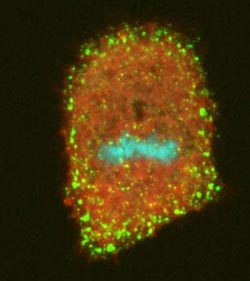Mitosis mystery solved as role of key protein is confirmed

This shows restarted endocytosis in a mitotic cell.<br><br>Credit: Royle/University of Warwick<br>
The study, published today in the journal eLife, is the first to outline the role of actin, a protein, in shutting down clathrin-dependent endocytosis during mitosis.
Endocytosis is the process by which cells absorb molecules that are too large to pass through the plasma membrane, such as proteins. Clathrin-dependent endocytosis is the most common route for this. Clathrin, a protein, forms a pit on the inner surface of the membrane which allows the cell to engulf and bring in a small volume of fluid from outside the cell.
The team, led by Dr Steve Royle, were able to answer a question that was first asked in 1965 by American cell biologist, Don Fawcett. Fawcett became aware that clathrin-dependent endocytosis shuts down during mitosis, but the understanding of why it happens has eluded researchers until now.
In the latter part of the 20th Century, two competing theories emerged. One theory suggested that the tension of the plasma membrane is too high for endocytosis to occur. The other theory stated that the cell actually switches off the proteins involved by a process of mitotic phosphorylation, the addition of a phosphate group to the cell proteins.
More recently, scientists found that in non-dividing cells, when membrane tension is high, endocytosis can still occur because actin can be recruited to help clathrin to overcome the high tension in the membrane.
The Warwick team measured membrane tension in mitotic cells and found it to be much higher than in non-dividing cells, thus sparking the investigation into why actin is not recruited to help out in this case. They found that during mitosis, actin is busy forming a stiff cortex in the cells and so cannot be used to help out endocytosis. In other words, actin is needed, but is unavailable for use.
By tricking the cell into making actin available during mitosis, the researchers were able to restart endocytosis in mitotic cells. The paper also describes how mitotic phosphorylation does not inhibit the process, arguing against the alternative theory.
The newfound appreciation for the role played by actin opens the door for further developments, both for researchers and for possible clinical applications.
Dr Royle explained, “The implications for human health are truly fascinating; by knowing the role played by actin we can look to use it to restart endocytosis during cell division. That could mean that we're able to make dividing cells receptive to pharmaceuticals or other medical treatments in a way that we haven't before.”
“It also opens up other strands of research and questions for our field. For instance, how does the cell know that the membrane tension is too high for normal endocytosis? When and how does it call in actin? There is plenty we are yet to discover.”
The research was funded by the Biotechnology and Biological Sciences Research Council (BBSRC).
Media Contact
More Information:
http://www.warwick.ac.ukAll latest news from the category: Life Sciences and Chemistry
Articles and reports from the Life Sciences and chemistry area deal with applied and basic research into modern biology, chemistry and human medicine.
Valuable information can be found on a range of life sciences fields including bacteriology, biochemistry, bionics, bioinformatics, biophysics, biotechnology, genetics, geobotany, human biology, marine biology, microbiology, molecular biology, cellular biology, zoology, bioinorganic chemistry, microchemistry and environmental chemistry.
Newest articles

A universal framework for spatial biology
SpatialData is a freely accessible tool to unify and integrate data from different omics technologies accounting for spatial information, which can provide holistic insights into health and disease. Biological processes…

How complex biological processes arise
A $20 million grant from the U.S. National Science Foundation (NSF) will support the establishment and operation of the National Synthesis Center for Emergence in the Molecular and Cellular Sciences (NCEMS) at…

Airborne single-photon lidar system achieves high-resolution 3D imaging
Compact, low-power system opens doors for photon-efficient drone and satellite-based environmental monitoring and mapping. Researchers have developed a compact and lightweight single-photon airborne lidar system that can acquire high-resolution 3D…





















